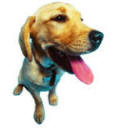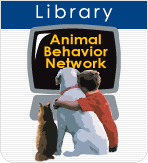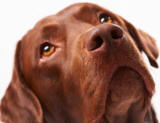|
Need Help?
|
|
Call
1-800-372-3706
to
speak to a Veterinary Behavior Technician |
|
Paws To Speak!
Member
Main Menu
|


|
 |
|
Help is at your
fingertips by library, email and
phone. |

Click on
Library Icon
to learn more
|
When does teething stop?
 Puppies
lose their "baby" teeth between 4 and 6 months of age. However, they
continue to grow molars through their first year. Dogs chew to
explore, to relieve teething, to release stress and to pass the time. Puppies
lose their "baby" teeth between 4 and 6 months of age. However, they
continue to grow molars through their first year. Dogs chew to
explore, to relieve teething, to release stress and to pass the time.
Dogs need a variety of safe
things to chew. Each dog is an individual. Some like to chew more than
others. However, you can encourage your dog to expend energy by chewing by
providing desirable chews and praising approved chewing behavior.
You may want to start off with
softer edible chews (vegetable based). As the dog develops a chewing
habit, you can
provide harder chews. PRAISE correct chewing. Do not allow access to inappropriate chews such as
socks or shoes, or very hard chews like sterilized bones until the dog is an
experienced chewer of approved items.
Chewing gives your dog something positive to do. When dogs are chewing on
something, they are generally calm and well-behaved.
Because most domestic pets eat commercial pet food, they don't reap the teeth-cleaning benefits that their ancestors did by gnawing on the bones of their prey. Plaque accumulates on pets' teeth and when the plaque hardens, it irritates the gums. Eventually bacteria start to grow under the gum tissue. The bone may also become infected. If the infection moves into the bloodstream, it can damage the kidneys or the heart valves. The same process affects people, too.
"You want me to do what?!?"
When veterinarians explain the key to dental health, a common reaction by the pet owner is, "You want me to do what?" What did the veterinarian say? Simply put, "Brush your pets' teeth daily."
|
Dental disease is one of the most common medical problems in
domestic dogs and cats. |
Start Teeth Brushing by taking Baby Steps!
1. Start with a relaxed dog and no toothbrush.
2. Introduce the
pet toothpaste on your finger by massaging the gums.
3. Introduce the finger brush one tooth, one session at a time.
4. Introduce the toothbrush coupled with treats and praise.
5. Begin brushing one or two teeth daily and phase out treats.
6. Increase the number of teeth brushed each session.
7. Always praise cooperative behavior during the brushing
What to look for
One sign of
dental problems are excessive drooling in pets that don't normally salivate
very much, loss of appetite or seeming to favor one side of his mouth.
|